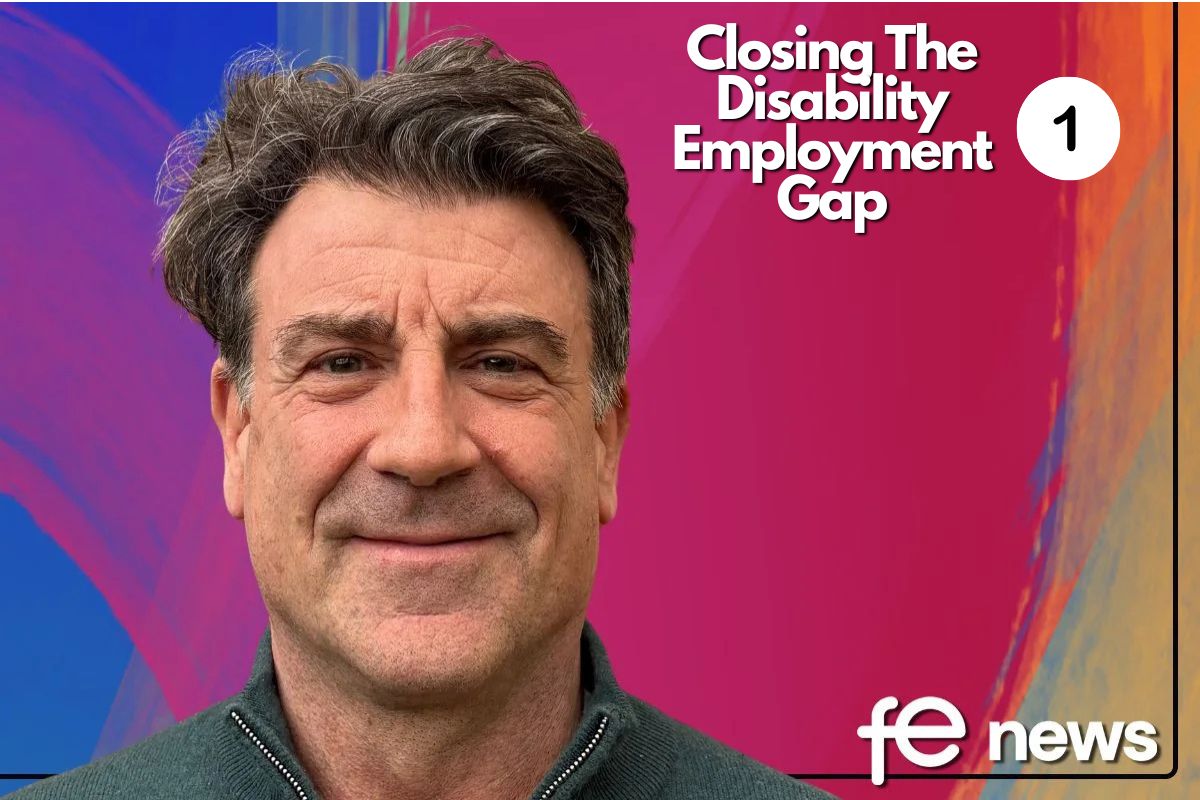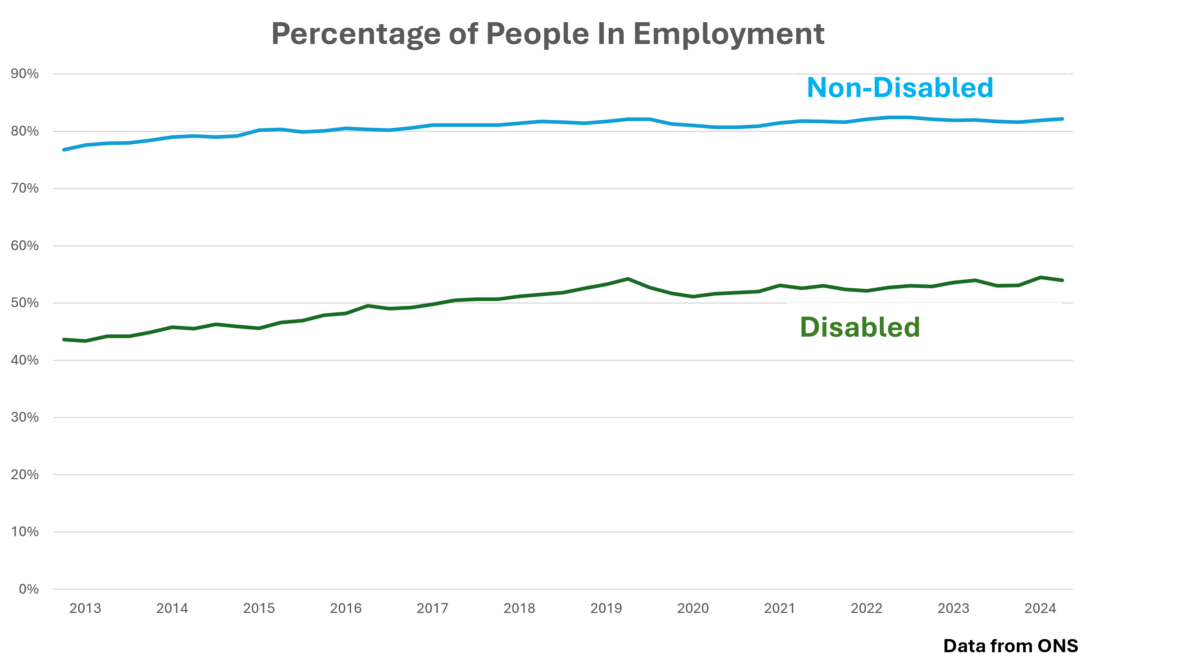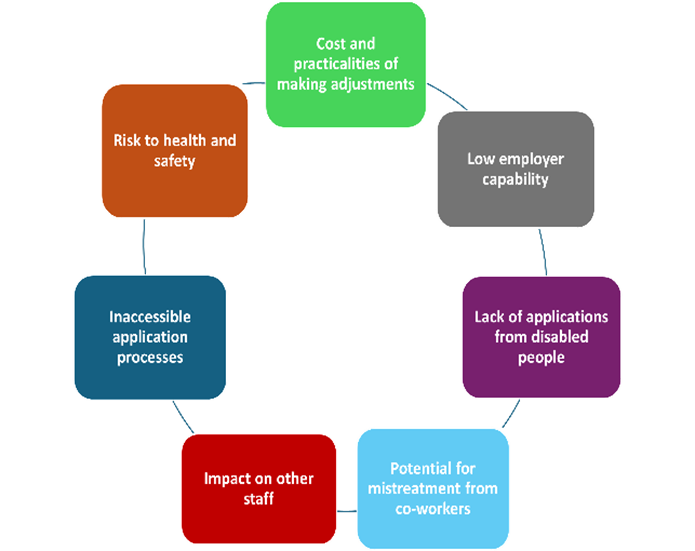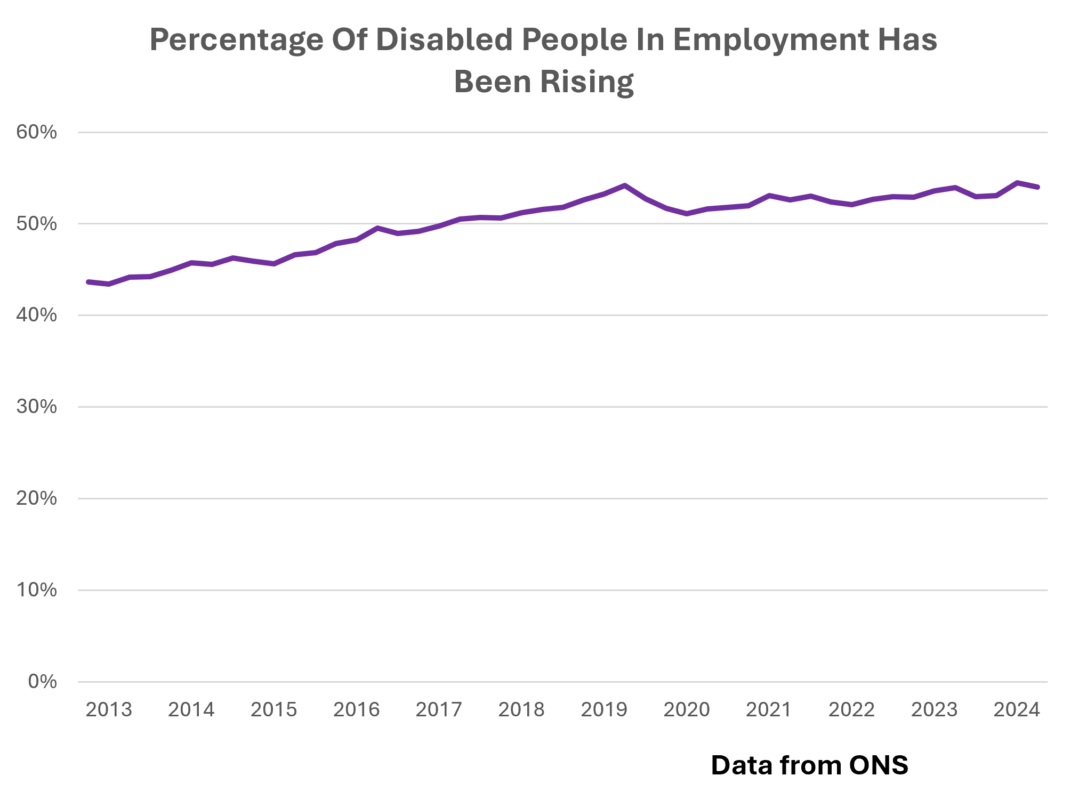Closing The Disability Employment Gap: Why Inclusive Hiring Is A Social And Economic Imperative

This article is the first in a three-part series exploring the disability employment gap. Closing this gap starts at school, where early interventions and inclusive education lay the foundation for future employability.
What’s Disability and the ‘Disability Employment Gap’?
Disability is broadly defined as a ‘long-term physical or mental health condition that significantly limits a person’s daily activities’. The UK’s 2010 Equality Act provides a legal framework protecting individuals with disabilities from discrimination, and yet significant barriers to employment persist. As you can see from the graphs, the ‘disability employment gap’ (DEG), which is the difference in employment rates between disabled and non-disabled individuals, has remained at around 30 percentage points across the UK for the past 5 years, with disabled individuals significantly less likely to be in employment than their non-disabled peers. Although the DEG has fallen over the past decade, it has remained stubbornly static in recent years, despite the legal protections and government policies aimed at improving disability inclusion – reflecting deeper structural inequalities in the labour market.
Social Justice and Workplace Inclusion


This disability differential isn’t there due to a lack of ability to do the job but rather because of systemic barriers which prevent fair access to opportunities. Discrimination, inaccessible workplaces and outdated hiring practices all contribute to this disparity, which Max Mosley of the National Institute of Economic and Social Research (NIESR) describes as “indefensible economically and morally.”
Workplace ‘inclusion’ is fundamentally an issue of social justice.
Social justice means recognising that all individuals, regardless of ability, deserve equal opportunities to contribute and thrive in society. The persistent exclusion of disabled workers is not only unfair but also a waste of human potential. For businesses, hiring disabled employees should not be seen as an act of charity but as a necessity for a truly equitable and high-functioning workforce.
Outdated Employer Attitudes, Systemic Barriers, and Hiring Biases
Outdated employer perceptions remain a major barrier to closing the DEG. Many still assume that hiring disabled workers requires costly accommodations or reduces productivity, despite strong evidence to the contrary. Systemic obstacles, such as inaccessible workplaces, inflexible job structures and limited career progression, further exclude disabled employees. On the barriers to hiring disabled people, employers mention a variety of issues, including:

Bias in recruitment also plays a role, with research showing that disabled applicants receive fewer interview opportunities than equally qualified non-disabled candidates. Also, disabled people have been found to be underrepresented among employees responsible for recruitment decisions: only 6% of such employees were disabled.
Misconceptions Perpetuated by the Regulators
Recently, the Financial Conduct Authority (FCA) and the Bank of England’s Prudential Regulation Authority (PRA), aligned with a broader shift in the UK and US towards reducing policies, have decided against introducing new DEI (Diversity, Equity, and Inclusion) rules for financial firms. While acknowledging the benefits of diversity in governance and risk management, they argue that additional regulatory requirements, such as mandatory pay gap reporting, would impose unnecessary costs. Instead, they will support more flimsy voluntary industry initiatives to promote diversity.
What’s the Business Case for Inclusion?
Employers often overlook the skills and resilience that disabled individuals bring to the workplace, reinforcing a cycle of exclusion. However, research consistently highlights that companies actively seeking disabled talent benefit from higher productivity, greater innovation, lower absenteeism rates and stronger company loyalty, leading to better retention. An inclusive workforce fosters creativity, resilience and innovation. By ensuring disabled employees have equal opportunities, businesses can tap into a wealth of diverse talent, bringing fresh perspectives and problem-solving approaches which benefit all.
For example, a systematic review in the Journal of Occupational Rehabilitation found that hiring disabled workers actually improves profitability, reliability, customer satisfaction, workplace culture, and safety. Similarly, research from the Institute for Corporate Productivity has found that employees with developmental disabilities contribute to increased productivity and customer loyalty.
Beyond performance benefits, inclusive businesses gain access to a wider talent pool, enhanced brand reputation and improved employee engagement. Additionally, workplace accessibility initiatives, such as flexible working arrangements originally designed for disabled employees, have been shown to improve job satisfaction and work-life balance for all staff.
By fostering a culture of inclusion, businesses not only fulfil ethical and legal responsibilities but also gain a competitive edge in an increasingly diverse and evolving economy.
The Economic Case For Inclusion: The Purple Pound
Excluding disabled individuals from the workforce is not just a social issue, it also has significant economic consequences. The UK economy loses billions each year due to lower employment rates among disabled people, with estimates suggesting a potential £50 billion boost from closing the disability employment gap. This ‘loss’ stems from reduced tax contributions, increased welfare reliance, and the underutilisation of a capable workforce. Additionally, workplaces that lack diversity miss out on fresh perspectives that drive innovation and problem-solving, both of which are crucial for economic growth.
Companies which fail to prioritise disability inclusion are not only missing out on skilled workers but also failing to engage with potential customers. The ‘purple pound’, that is, the spending power of disabled people and their households, is a growing economic force. Companies which cater for this demographic benefit from increased customer loyalty and market share, which is worth an estimated £274 billion annually in the UK. However, three-quarters of disabled customers report abandoning businesses due to poor accessibility or inadequate customer service. Accessibility is not just about compliance, but also it is a strategic opportunity for growth.
So, closing the disability employment gap would not only strengthen businesses but also benefit the broader economy. Increased employment among disabled individuals would boost GDP, reduce government spending on benefits and enhance consumer spending power, creating a more financially independent and engaged society.
Breaking Down Barriers for a More Inclusive Future
The barriers to employment for disabled individuals don’t begin in adulthood, they start in school. Limited access to inclusive education, career guidance, and real-world work experiences prevents young people with special educational needs and disabilities (SEND) from developing the skills and confidence they need to transition into meaningful careers. As illustrated in the graph, the number and percentage of disabled people in employment has been rising, but, if we are serious about closing the disability employment gap, we need to look beyond hiring policies and focus on the entire pipeline – from education to employment.

Teachers, schools and training providers play a crucial role in shaping the aspirations and opportunities of young people with SEND. By embedding career development into the curriculum, providing tailored guidance, and ensuring access to work-based learning, we can equip SEND students with the skills they need to thrive. Collaboration between educators and employers is key and when businesses engage with schools early, they help create pathways which lead to real job opportunities, not just theoretical aspirations.
The benefits of breaking down these barriers are undeniable. Businesses which embrace disability inclusion gain access to a diverse, innovative workforce, while society as a whole benefits from increased economic participation, reduced welfare dependency and stronger communities. The classroom is where this change begins. By fostering inclusive education and career development, we can build a future where every young person, regardless of ability, has the opportunity to contribute, succeed, and reach their full potential.
By Neil Wolstenholme, Kloodle Chairman











Responses